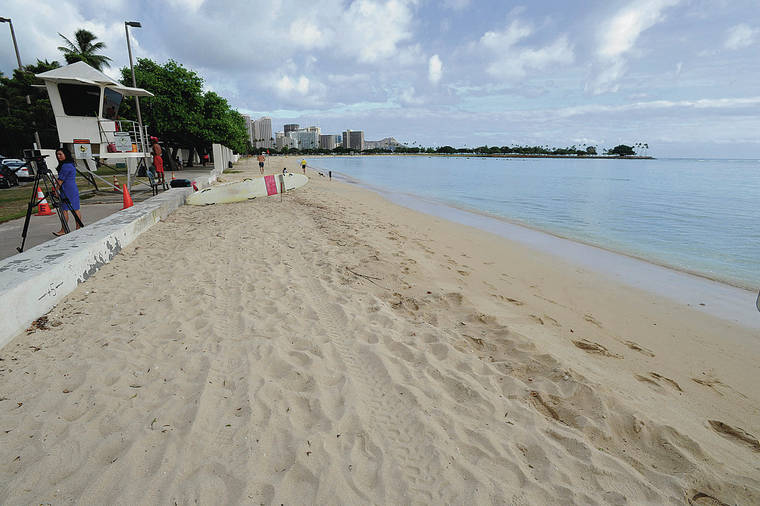Land Board approves Ala Moana beach nourishment plan

STAR-ADVERTISER / 2016
The city intends to add sand to the beach at Ala Moana Regional Park. Above, shoreline at the park near lifeguard stand 1-C near McCoy Pavilion, looking toward Magic Island.
The City of Honolulu’s application to add sand to the beach at Ala Moana Regional Park was approved Friday by the state Board of Land and Natural Resources after a public hearing.
The project is to dredge offshore sand to cover the shoreline from Magic Island to Kewalo Basin, restoring the beach to its 1957 profile.
Four members of the public testified in opposition, pressing on past the three-minute time limit despite admonitions by DLNR Chairwoman Suzanne Case.
“Rocky areas are treasures, not threats,” said Bruce Lum of Save Ala Moana Beach Park, who said the rubble provides a fish nursery, notably at Kewalo Basin.
“The rocky area is natural,” Lum said, adding it was also an important cultural resource for local people “to transfer manao (knowledge) through generations.”
His wife, Shar Chun-Lum, requested the board defer its decision and hold more hearings, and Audrey Lee of Malama Moana worried about pollutants in offshore sand and environmental impacts of dredging.
Don't miss out on what's happening!
Stay in touch with breaking news, as it happens, conveniently in your email inbox. It's FREE!
Bianca Isaki said the plan was “not sustainable for an area that’s going to be underwater under sea level rise scenarios,” and that sand would silt the beach’s popular swim channel.
“I’ve seen tako come up to the shoreline and grab crabs early in the morning, and I wonder how dredging would affect hammerhead (shark) breeding grounds in the area,” Isaki said, concluding the potential risks were “not worth (making) this beach into a condo amenity,” referring to the luxury condominiums on the mauka side of Nimitz Highway, overlooking the beach park.
Dave Smith of Sea Engineering, which performed research for the plan’s draft and final environmental impact statements, responded that growing coral at the center of the beach would be relocated to the Kewalo end, “which is not going to be completely covered with sand.”
He added the sand sources had been studied and found not to be contaminated.
Board members James Gomes, Vernon Char and Samuel Gon suggested the board defer a decision until cultural impacts could be fully vetted.
Board member Chris Yuen said that “when you try to go in the water, the rocks poke your feet,” so he was inclined to approve the application.
There was discussion about which sand deposit to dredge. The city’s preferred source lay 4,500 feet directly offshore of the surf break named Courts, for the park’s tennis courts; while sand at the Hilton Hawaiian Village beach could be used as backup if needed.
But DLNR’s Office of Conservation and Coastal Lands recommended the Hilton sand be used as the primary source, being slightly coarser in grain and a closer match to the Ala Moana beach sand, while the offshore sand, which is a finer grain, could cause longer-term turbidity “to the extent that it may approach an unacceptable situation.”
Smith responded that turbidity tests had been conducted, and there would be no difference with either source.
Sam Lemmo, OCCL administrator, noted the Hilton deposit’s proximity to the celebrated surf spot Bowls near Magic Island, “and even though we don’t feel there will be an impact, still, a lot of surfers might not feel too happy about that.”
The offshore dredging and beach nourishment plan was one of several features that drew strong public opposition in 2019 in the city’s Ala Moana Regional Park Master Plan, including a playground, dog park and perpendicular parking stalls that were eventually dropped.
On Friday the board also approved the city’s application to rebuild the eroded seawall at Queen’s Beach, Waikiki.




